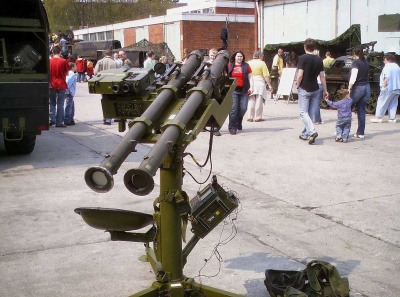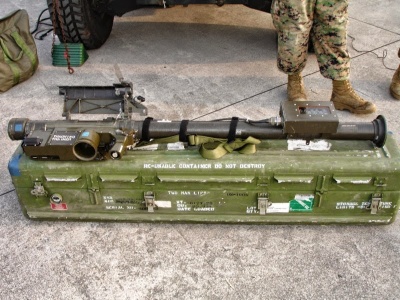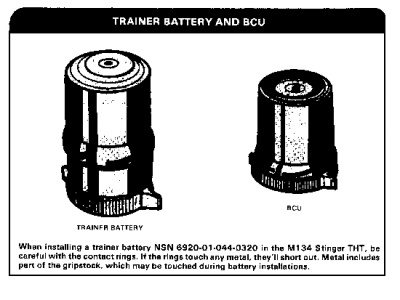| If you have been locked out of your account you can request a password reset here. |
Difference between revisions of "FIM-92 Stinger"
| Line 11: | Line 11: | ||
In 1991 the US Marine Corps began a program called WASP (Wide-Angle Stinger Pointer) to develop a night-vision sight for the Stinger. Raytheon designed a sight derived from their existing AN/PAS-13B, the AN/PAS-18, which was adopted by the USMC as the Stinger Night Sight (SNS) in 1993. The SNS is a passive night-vision scope that attaches to the top of the launch tube: as well as the USMC, it has also been adopted by the German Air Force as part of the VSHORAD (Very Short Range Air Defence) system, and Euroatlas GmbH has produced a variant of the design adapted to fit on the Russian SA-16 "Gimlet" missile system. | In 1991 the US Marine Corps began a program called WASP (Wide-Angle Stinger Pointer) to develop a night-vision sight for the Stinger. Raytheon designed a sight derived from their existing AN/PAS-13B, the AN/PAS-18, which was adopted by the USMC as the Stinger Night Sight (SNS) in 1993. The SNS is a passive night-vision scope that attaches to the top of the launch tube: as well as the USMC, it has also been adopted by the German Air Force as part of the VSHORAD (Very Short Range Air Defence) system, and Euroatlas GmbH has produced a variant of the design adapted to fit on the Russian SA-16 "Gimlet" missile system. | ||
| − | Note: Before adding to this list, make sure that you have checked the [[FIM-43 Redeye]] page. For a brief guide in differentiating these two weapons, see the bottom of this page. For a brief guide to the actual firing procedure of a Stinger (which is very rarely shown correctly in media) seen the | + | Note: Before adding to this list, make sure that you have checked the [[FIM-43 Redeye]] page. For a brief guide in differentiating these two weapons, see the bottom of this page. For a brief guide to the actual firing procedure of a Stinger (which is very rarely shown correctly in media) seen [[Talk:FIM-92_Stinger#Stinger_firing_procedure|this section]] on the discussion page. |
==Specifications== | ==Specifications== | ||
| Line 229: | Line 229: | ||
|- | |- | ||
|} | |} | ||
| − | |||
| − | |||
| − | |||
| − | |||
| − | |||
| − | |||
| − | |||
| − | |||
| − | |||
| − | |||
==How to tell the FIM-92 Stinger from the FIM-43 Redeye== | ==How to tell the FIM-92 Stinger from the FIM-43 Redeye== | ||
Revision as of 02:05, 20 December 2017
The FIM-92 Stinger is the US military's principle man-portable air defence system (MANPADS). It was initially developed as a simple upgrade to the FIM-43 Redeye by General Dynamics, and was called the FIM-43 Redeye II before being designated as FIM-92 in 1971 and Stinger in 1972. Technical challenges meant the first successful shoulder launch did not take place until 1975, with the initial "A" variant entering production in 1978. Originally developed as a pure passive IR-seeking system and updated to use dual-mode passive IR / UV starting with the FIM-92B in 1983, it is a fire-and-forget weapon using a soft-launch missile with a two-stage main booster, with the business end a 6.6-pound hit-to-kill annular blast fragmentation warhead. In infantry use, it is typically issued to a two-man crew.
A Stinger has two main parts: the larger is the disposable Launch Tube Assembly, which incorporates the fiberglass launch tube, a 22-pound, 5-foot encased missile with an attached launch motor, and the weapon's sighting unit. The other is the reusable gripstock assembly, which includes the trigger assembly, controls, and the folding IFF (identify friend or foe) antenna. Two additional parts are the BCU (battery coolant unit) cartridge which is inserted into a well in the underside of the gripstock with a quarter-turn to lock it (something which is almost never shown being done in media) and provides a 45 second supply of power from a thermal battery and argon coolant gas for the missile seeker once activated, and the optional IFF interrogator, a small computer which is worn on the user's belt and connects to the base of the pistol grip via a wire. Without the latter, the weapon's IFF antenna does nothing: with it, the system can interrogate targets, identifying them as either friendly or unknown. The IFF only provides a "beep" response when the "challenge" button on the launcher is pressed (many short beeps means unknown, two half-second beeps at a half-second interval means positive friend, one 1.5 second beep a possible friend, no beep a malfunction), it does not prevent the Stinger from locking on or firing. The Stinger does not require the IFF antenna to be open in order to fire: frequently it is shown in the deployed position in media in scenarios where there would be no need for it or without the interrogator connected, seemingly just because it looks good.
A complete Stinger is issued as a single "weapon-round" (as opposed to a "missile-round," which is just the LTA: Stingers are shipped long distances with the gripstocks separated to reduce their usefulness if stolen) in a protective case with either three or five BCUs, an IFF interrogator and a set of earplugs (FM 44-18-1 warns that permanent deafness will result from exposure to more than two firings without ear protection). While the gripstock is reusable, a Stinger team is usually only issued with two missile-rounds compared to four weapon-rounds, so it is not common for a Stinger to be "reloaded" in the field. Mating the gripstock to an LTA requires a protective cover be removed from the LTA's underside: the gripstock then slides into position and is locked with a latch at the front of the assembly.
In 1991 the US Marine Corps began a program called WASP (Wide-Angle Stinger Pointer) to develop a night-vision sight for the Stinger. Raytheon designed a sight derived from their existing AN/PAS-13B, the AN/PAS-18, which was adopted by the USMC as the Stinger Night Sight (SNS) in 1993. The SNS is a passive night-vision scope that attaches to the top of the launch tube: as well as the USMC, it has also been adopted by the German Air Force as part of the VSHORAD (Very Short Range Air Defence) system, and Euroatlas GmbH has produced a variant of the design adapted to fit on the Russian SA-16 "Gimlet" missile system.
Note: Before adding to this list, make sure that you have checked the FIM-43 Redeye page. For a brief guide in differentiating these two weapons, see the bottom of this page. For a brief guide to the actual firing procedure of a Stinger (which is very rarely shown correctly in media) seen this section on the discussion page.
Specifications
(1981-present)
Type: MANPADS (FIM-92), air-to-air missile (AIM-92 ATAS and ATAL)
Caliber: 70mm (2.76in) Missile, hit-to-kill annular blast fragmentation warhead (added proximity sensor on FIM-92J)
Capacity: 1 missile, disposable launcher
System weight: FIM-92A: 33.5 lb (15.19 kg)
Missile weight: 22 lb (10.1 kg)
Length: 59.8 in (1.52 m)
Fire Modes: Single shot, IR homing (FIM-92A), dual IR and UV homing (FIM-92B and later), IR, UV and passive radar (Stinger ADSM), imaging infrared (Stinger RMP Block II, cancelled)
The FIM-92 'Stinger' shoulder-fired Surface to Air Missile (SAM) has appeared used by the following actors in the following movies, video games, and television series:
Film
In live-action works a "Stinger" is usually a real, expended Stinger launch tube with its integrated sighting unit (as these are in many jurisdictions treated as expended rounds of ammunition), mounted on a prop gripstock unit. These props can be distinguished from a real gripstock by inaccuracies in the IFF antenna design (which is often rather wobbly) and often having a totally flat front, without the latch for attaching the gripstock to the launch tube.
| Title | Actor | Character | Note | Date |
|---|---|---|---|---|
| Fire Birds | Sean Young | CWO Billie Lee Guthrie | With a real gripstock | 1990 |
| Fire Birds | Mounted on AH-64 Apache helicopters | 1990 | ||
| Under Siege | Henchmen | 1992 | ||
| True Lies | Crimson Jihad terrorists | 1994 | ||
| Soldier Boyz | Vinh Moc's soldier | 1995 | ||
| Canadian Bacon | Kevin J. O'Connor | Roy Boy | 1995 | |
| 2009: Lost Memories | Fureisenjin terrorists | Spent tube with no gripstock | 2002 | |
| Charlie Wilson's War | Mujahadeen fighters | 2007 | ||
| Charlie Wilson's War | Tom Hanks | Charlie Wilson | 2007 | |
| The Day the Earth Stood Still | U.S. Army soldier | Mounted on M1097 Avenger Humvee | 2008 | |
| Terminator: Genisys | Resistance fighter | 2015 | ||
| London Has Fallen | Terrorists | Prop gripstock and blown-out IR window | 2016 |
Television
| Show Title | Actor | Character | Note/Episode | Air Date |
|---|---|---|---|---|
| Miami Vice | Philip Michael Thomas | Detective Ricardo Tubbs | 1984-1989 | |
| JAG | Lee Tergesen | Gunnery Sgt. Gentry | "Brig Break" | 1995 |
| Stargate SG-1 | U.S military personnel | "Children of the Gods" (S1E01) | 1997 | |
| NCIS | seen in weapons cache; "Enigma" (S1E15) | 2004 | ||
| JAG | Terrorist | "A Tangled Webb, Part I" (S8E24) | 2008 | |
| Doctor Who | British Army soldiers | "Doomsday" (S2E13), Incorrectly used against ground targets | 2006 | |
| The Unit | Scott Foley | Sgt. Bob Brown | "Eating the Young" (S1E09) | 2006 |
| CSI: Miami | Vincent Laresca | Antonio Riaz | "One of Our Own" (S4E25) | 2006 |
| Lost | "Cabin Fever" (S4E11) | 2008 | ||
| Doctor Who | UNIT soldiers | "Poison Sky" (S4E05); Incorrectly used against ground targets | 2008 | |
| Branch (Expozitura) | The assassins | 9th/ "Král je mrtev" | 2009 | |
| Meteor | Army National Guard | 2009 | ||
| The Blacklist | seen in weapons sale; "The Stewmaker (No. 161)" (S1E04) | 2013 |
Video Games
| Game Title | Appears as | Mods | Notation | Release Date |
|---|---|---|---|---|
| Enemy Engaged: Apache/Havoc | Shoulder and vehicle-mounted | 1998 | ||
| Ace Combat 5: The Unsung War | Non-playable | 2004 | ||
| Ace Combat: Assault Horizon | Simplistic launcher model designed to produce a convincing shadow | 2011 | ||
| Metal Gear 2: Solid Snake | 1990 | |||
| Metal Gear Solid: The Twin Snakes | 2004 | |||
| Metal Gear Solid 2: Sons of Liberty | 2001 | |||
| Metal Gear Solid 4: Guns of the Patriots | 2008 | |||
| Operation Flashpoint | AA Launcher | 2001 | ||
| Conflict: Desert Storm | 2002 | |||
| Joint Operations: Typhoon Rising | 2004 | |||
| Söldner: Secret Wars | 2004 | |||
| Call of Duty 4: Modern Warfare | 2007 | |||
| ArmA: Armed Assault | 2007 | |||
| Resident Evil 2 | 1998 | |||
| Grand Theft Auto: San Andreas | 2004 | |||
| Battlefield 2 | In twin turret mount and quad launcher on M6 Linebacker | 2005 | ||
| Shadow Force: Razor Unit' | AA Launcher | 2002 | ||
| America's Army | Stored in crates in multiplayer mode, non-playable | 2002 | ||
| Mercenaries 2: World in Flames | 2008 | |||
| Operation Flashpoint 2: Dragon Rising | With AN/PVS-4 Thermal Scope | 2009 | ||
| Modern Warfare 2 | Stinger | 2009 | ||
| Resident Evil 5 | Desperate Escape DLC | 2009 | ||
| Project Reality | Shoulder, twin turret, and vehicle-mounted | 2005 | ||
| Battlefield Play4Free | In twin turret mount | 2011 | ||
| World in Conflict | 2007 | |||
| Modern Warfare 3 | 2011 | |||
| Operation Flashpoint: Red River | 2011 | |||
| Project Reality: Falklands | Shoulder and twin turret mount | 2012 | ||
| Resident Evil: Revelations | 2012 | |||
| Ravaged | 2012 | |||
| Metal Gear Rising: Revengeance | Homing Missile | "Futurised" version with radome instead of IFF antenna | 2013 | |
| Grand Theft Auto V | Homing Launcher | incorrectly muzzle loaded with warhead outside like RPG-7 | 2013 |
Anime
| Character | Film Title | Note | Date |
|---|---|---|---|
| Gokumon | Violence Jack: Hell's Wind Hen | 1990 | |
| Kuze | Ghost in the Shell Stand Alone Complex 2nd Gig | 2004 - 2005 | |
| Dejima refugees | Ghost in the Shell Stand Alone Complex 2nd Gig | 2004 - 2005 | |
| JGSDF soldiers | Saikano | 2006 | |
| Kiefer | Rideback | 2009 | |
| Major Pollack's militia | Jormungand | Refurbished FIM-92As | 2012 |
Training Set Guided Missile M134
The M134 is an inert system that is used to train Stinger gunners in target tracking and acquisition and is only capable of firing a large blue dummy missile to acclimate gunners to the feeling of the missile exiting the tube. A large performance indicator box is fitted to the rear-left of the LTA. Instead of a BCU it uses a training battery inserted into the same well which is 3 inches longer and around twice as heavy: this has enough power for 16 47-second training sessions. It is issued with a dummy IFF interrogator which provides random responses, though it is compatible with the real IFF interrogator unit too.
There is also a totally inert training version of the Stinger, the M60 Field Handling Trainer, which is used purely for handling and manual of arms drills.
Video Games
| Game Title | Appears as | Mods | Notation | Release Date |
|---|---|---|---|---|
| Battlefield 3 | FIM-92 Stinger | With performance indicator removed, incorrectly shown as a live weapon | 2011 | |
| Battlefield 4 | FIM-92 Stinger | With performance indicator removed, incorrectly shown as a live weapon | 2013 |
How to tell the FIM-92 Stinger from the FIM-43 Redeye
The Redeye is an earlier MANPAD which is similar in outward appearance to the Stinger and due to the fact that it has since been retired from active service with the US military there are a higher number of deactivated launchers on the market meaning that it often stands in for the Stinger in live-action films and television (The FIM-92 Stinger is in fact an evolution of the FIM-43 Redeye, with developmental name of the Stinger being the "Redeye II"). There are however several key differences which can be used to identify a launcher as a Redeye:




